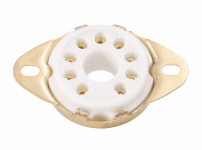Hello!
Can you guys advice on mounting ceramic bases like the one in the picture? I believe they are designed to be mounted under the chassis, but not sure how to handle the bit that stands out on the mounting hole.
Any advice is appreciated.
Regards,
Jose
Can you guys advice on mounting ceramic bases like the one in the picture? I believe they are designed to be mounted under the chassis, but not sure how to handle the bit that stands out on the mounting hole.
Any advice is appreciated.
Regards,
Jose
Attachments
Thank you!Can be installed either way.
What about the protuberance on the top of the mounting holes? Should the chassis hole be shaped like it if mounted from the bottom side? Any advice on how to avoid cracking when tightening?
Last edited:
I don't. Never had a problem with cracking.Thank you!
Should the chassis hole be shaped like it if mounted from the bottom side?
With those I would put some sort of flexible washer/gasket material between the chassis and the flange around the mounting holes.
Those are about the only Novar sockets left on the planet, so there isn’t much choice to use them and it’s prudent to be careful with them. Not exactly the most solderable lugs on them, either. Forget that lead free $***.
Those are about the only Novar sockets left on the planet, so there isn’t much choice to use them and it’s prudent to be careful with them. Not exactly the most solderable lugs on them, either. Forget that lead free $***.
They could be Magnoval either. Same pin circle diameter, but thinner pins (1 mm vs. 1,2 mm afaik). Have some of them in my drawers. Hope Jose knows exactly what they are 😉 .
Best regards!
Best regards!
Well, they were advertised as B9D sockets. I tried 6P41S, PL504/8/9, insertion force feels the same with all of them. Not as tight as the Chinese B9Ds, which, in my opinion, are too tight.They could be Magnoval either. Same pin circle diameter, but thinner pins (1 mm vs. 1,2 mm afaik). Have some of them in my drawers. Hope Jose knows exactly what they are 😉 .
Best regards!
I make a Novar socket... https://www.diyaudio.com/community/...-usa-large-9-pin-tubes-with-1-mm-pins.378427/With those I would put some sort of flexible washer/gasket material between the chassis and the flange around the mounting holes.
Those are about the only Novar sockets left on the planet, so there isn’t much choice to use them and it’s prudent to be careful with them. Not exactly the most solderable lugs on them, either. Forget that lead free $***.
Novar is mostly for USA tubes, right?I make a Novar socket... https://www.diyaudio.com/community/...-usa-large-9-pin-tubes-with-1-mm-pins.378427/
Yes, maybe because of the pin diameter that they shared with Compactrons. But also the legendary Philips/La Radiotechnique EL520 featured them, in contrast to it's successor, the also legendary, scarce and $$$ EL503, the same tube but with Magnoval socket and the same pinout.
Best regards!
Best regards!
Yep.Novar is mostly for USA tubes, right?
I designed it after I found out that my 12GT5 tubes were loose in the Chinese Magnoval sockets and real ones are almost unobtainable.
Exactly. IIRC, the ones in post 1 were made by Svetlana originally, so when they’re gone they’re gone. I bought some of the 12 pin versions of the ones in post 10. And I have trouble getting the pins to line up when plugging in tubes and have to be very careful. The overall quality is dubious.Yep.
I designed it after I found out that my 12GT5 tubes were loose in the Chinese Magnoval sockets and real ones are almost unobtainable.
I have found those sockets to be the only kind that properly hold noval or magnoval pins, can't recall which at the moment. Maybe the thinner pins because they are loose in a lot of the Chinese sockets. Anyhow with light torque they shouldn't crack.
I managed to crack one of these Russian sockets. The lack of the usual somewhat springy metal ring suggests to me that they were designed to be screwed down to a more compliant material rather than to a metal chassis. They are, after all, intended for the Russian tv tubes 6P36S, 6P41S and 6P42/45S. The Chinese ones have the ring, so shouldn’t require to be tightened down so hard. I use a small drill to carefully open out the pins.
I just measured the pins of a PL504, PL508 and 6P41S, all exactly the same at around 1.25mm.I managed to crack one of these Russian sockets. The lack of the usual somewhat springy metal ring suggests to me that they were designed to be screwed down to a more compliant material rather than to a metal chassis. They are, after all, intended for the Russian tv tubes 6P36S, 6P41S and 6P42/45S. The Chinese ones have the ring, so shouldn’t require to be tightened down so hard. I use a small drill to carefully open out the pins.
- Home
- Amplifiers
- Tubes / Valves
- Mounting ceramic sockets

